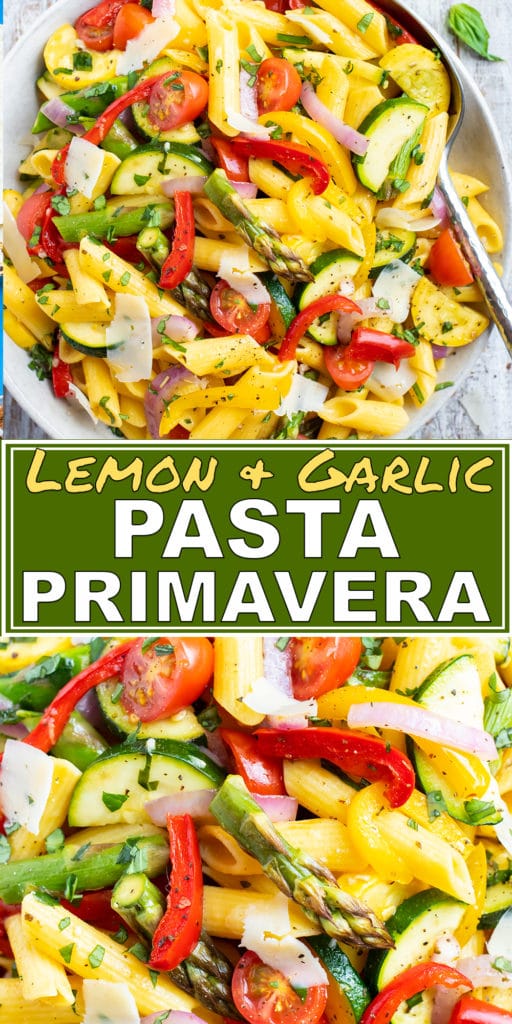Pasta Primavera with Lemon Garlic Butter is a quick and easy weeknight dinner recipe that is packed full of vegetables. Simply toss pasta, asparagus, tomatoes, squash, onions, bell peppers, and Parmesan cheese in a delicious butter sauce. This dish is the perfect dinner on a hot summer night or as a side at a BBQ!
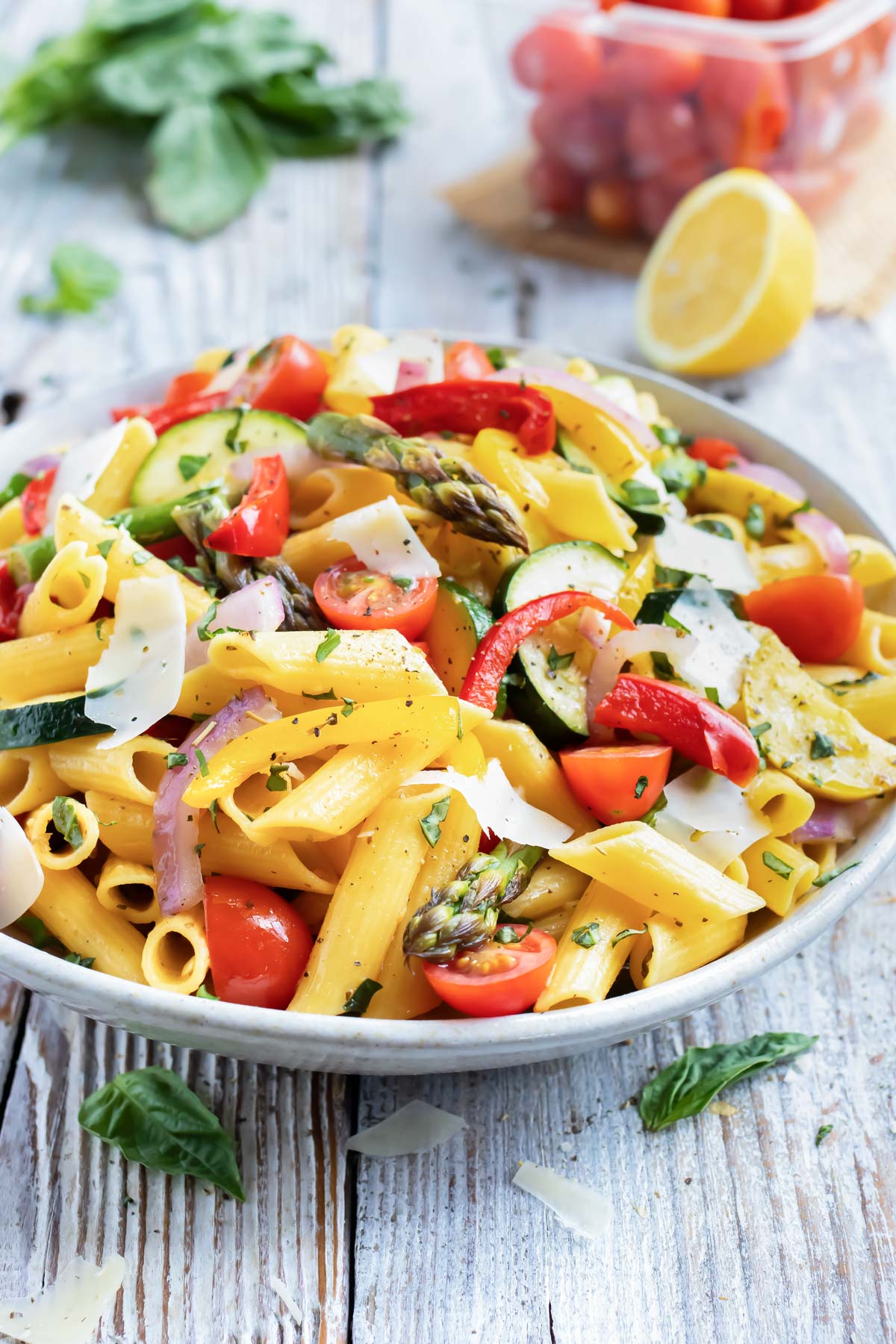
As the warmer Spring and Summer months are upon us, the grocery stores and backyard gardens start to burst with TONS of fresh summer vegetables.
And what better way to use up all of those veggies than to roast them up in the oven and toss them together with a bunch of pasta and some lemon butter garlic sauce! It’s one of our go-tos in these hotter months!
If you have never had Pasta Primavera, you are in for a REAL treat. It’s a super easy way to use up any vegetables you happen to have on hand while still getting to enjoy a filling dish.
Plus, this recipe is SO versatile! Add some protein like chicken or shrimp or even use gluten-free pasta. Throw in extra veggies like peas, broccoli, or carrots to amp up the nutritional content.
What is Pasta Primavera?
Pasta Primavera is an American dish made from pasta, fresh Spring and Summer vegetables, and a light lemon or butter sauce.
This dish was invented in the 1970s and can be found at many popular Italian restaurants, such as Olive Garden. Or, you can make your own version at home!
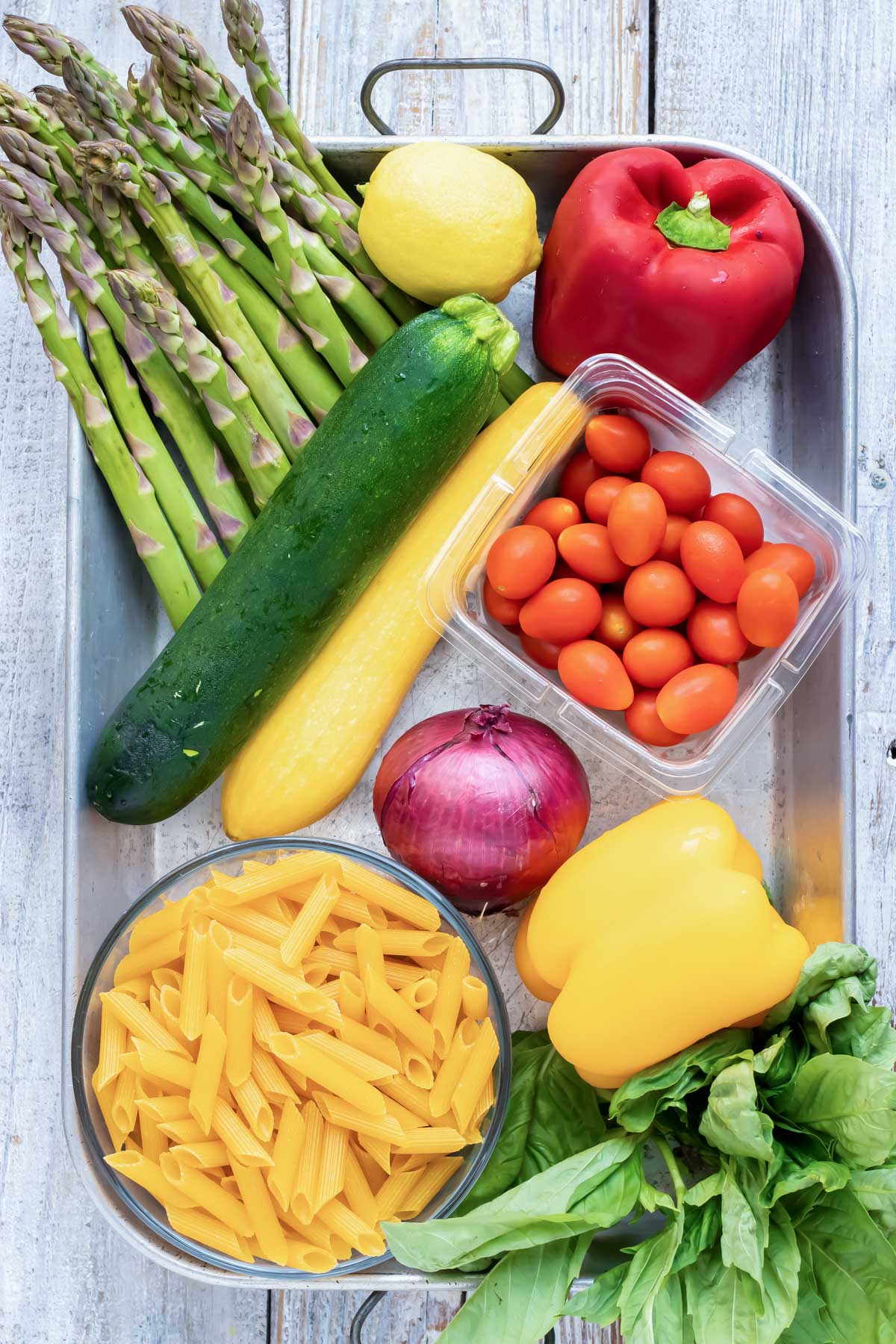

Ingredients
There may initially seem like a lot of ingredients in this Pasta Primavera recipe, but many of them can be substituted for whatever you happen to have on hand.
- Pasta. While linguine or spaghetti can be used, I tend to prefer either penne pasta, bowtie, or fusilli. You can also easily substitute a gluten-free variety, as well.
- Squash. Zucchini and yellow squash are both used in this recipe, but you can choose to use just one or the other.
- Bell Peppers. Feel free to select whatever color of bell pepper you happen to have.
- Asparagus. When cut into bite-sized pieces this bright green vegetable gives this dish a wonderful crunch.
- Italian Seasoning. Using this blend is the easiest way to give your recipe a delicious Italian flavor with a few common dried herbs.
- Olive Oil. A good quality olive oil will impart a remarkable flavor in this vegetable pasta recipe.
- Lemon Garlic Butter Sauce. This creamy dressing is full of fresh flavors and is the perfect topping for pasta. Read more below about how to make this easy sauce.
- Parmesan Cheese. Grated cheese is tangy yet sweet. You can also use a vegan Parmesan cheese if you are avoiding dairy or animal products.
- Basil. Fresh basil really gives this dish a bright flavor!
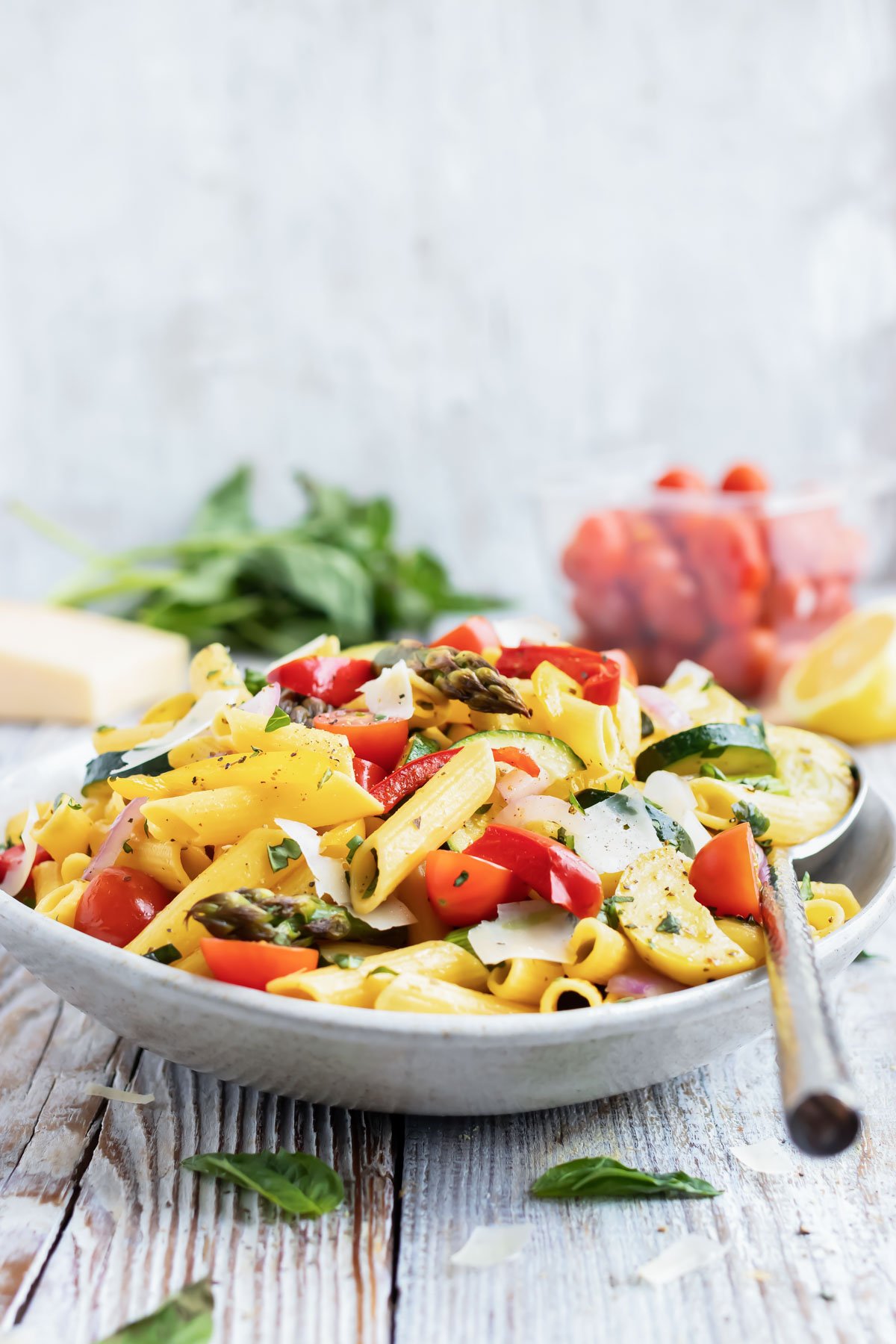

How to Make Pasta Primavera
Below you’ll find the steps to follow to make this Pasta Primavera recipe.
Chop Ingredients
Use a sharp knife to dice the onion, asparagus, squash, and peppers.
Be sure to cut everything into even, bite-sized pieces. This way, they will roast consistently in the oven.
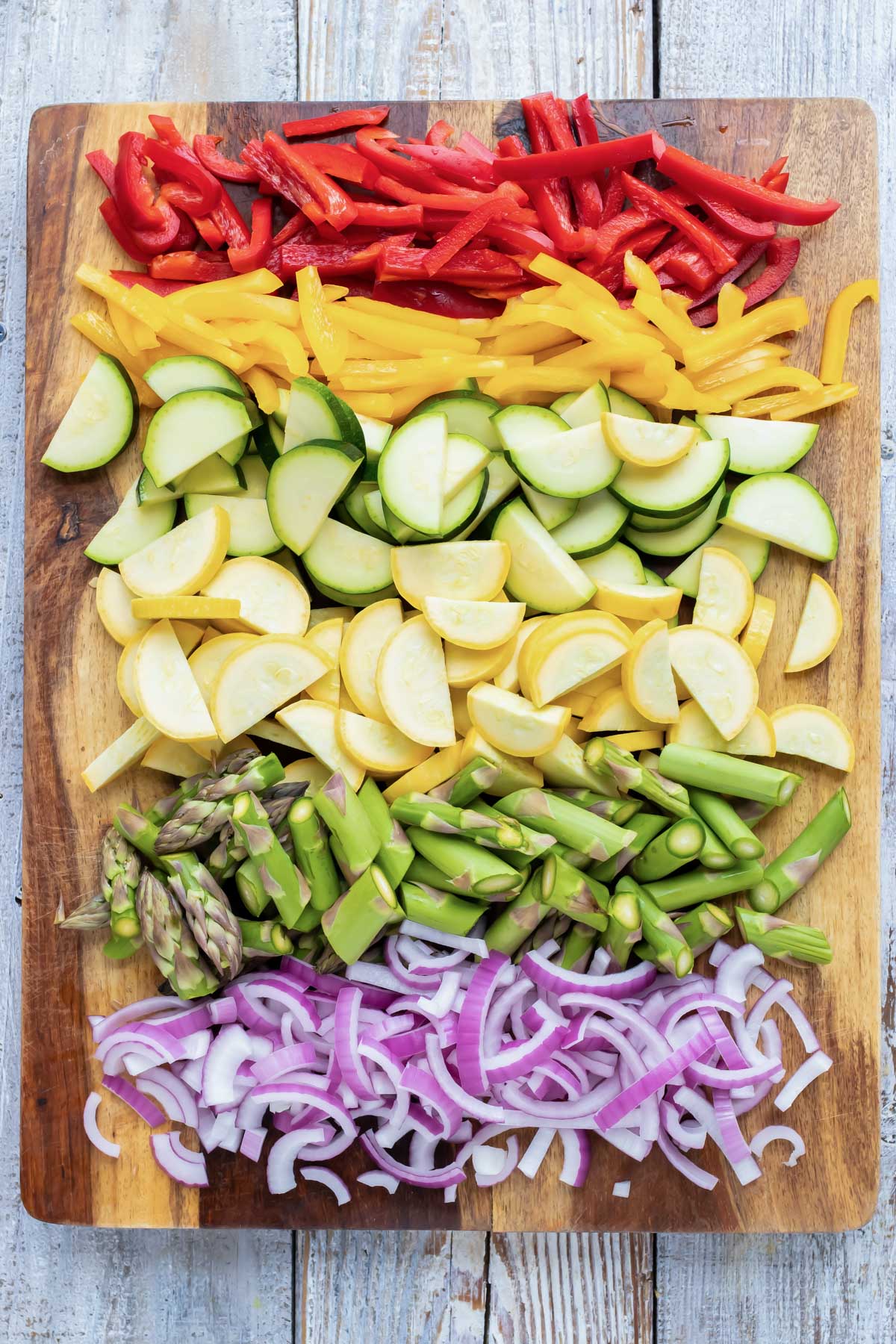

Roast the Veggies
Preheat the oven to 425℉.
Toss all of the vegetables together with a bit of olive oil, Italian seasonings, salt, and pepper.
Lay vegetables on a parchment paper-lined baking sheet and bake for 15-17 minutes.
Some pasta primavera recipes ask you to steam or sauté the spring vegetables. However, I find that roasting the vegetables gives them a subtle sweetness and an incredible texture while also avoiding a soggy result.
A Few Tips when Roasting the Vegetables:
- Do not add too much oil. This will result in limp vegetables instead of crisp.
- Make sure you have a large enough baking sheet. You want the vegetables to be in a single layer.
- Only substitute vegetables with others that cook at a similar rate. You do not want to add vegetables that take a long time to cook (i.e. potatoes, beets, etc.)
This recipe was inspired by this Roasted Vegetable Pasta Bake and this Italian Roasted Vegetables recipe.
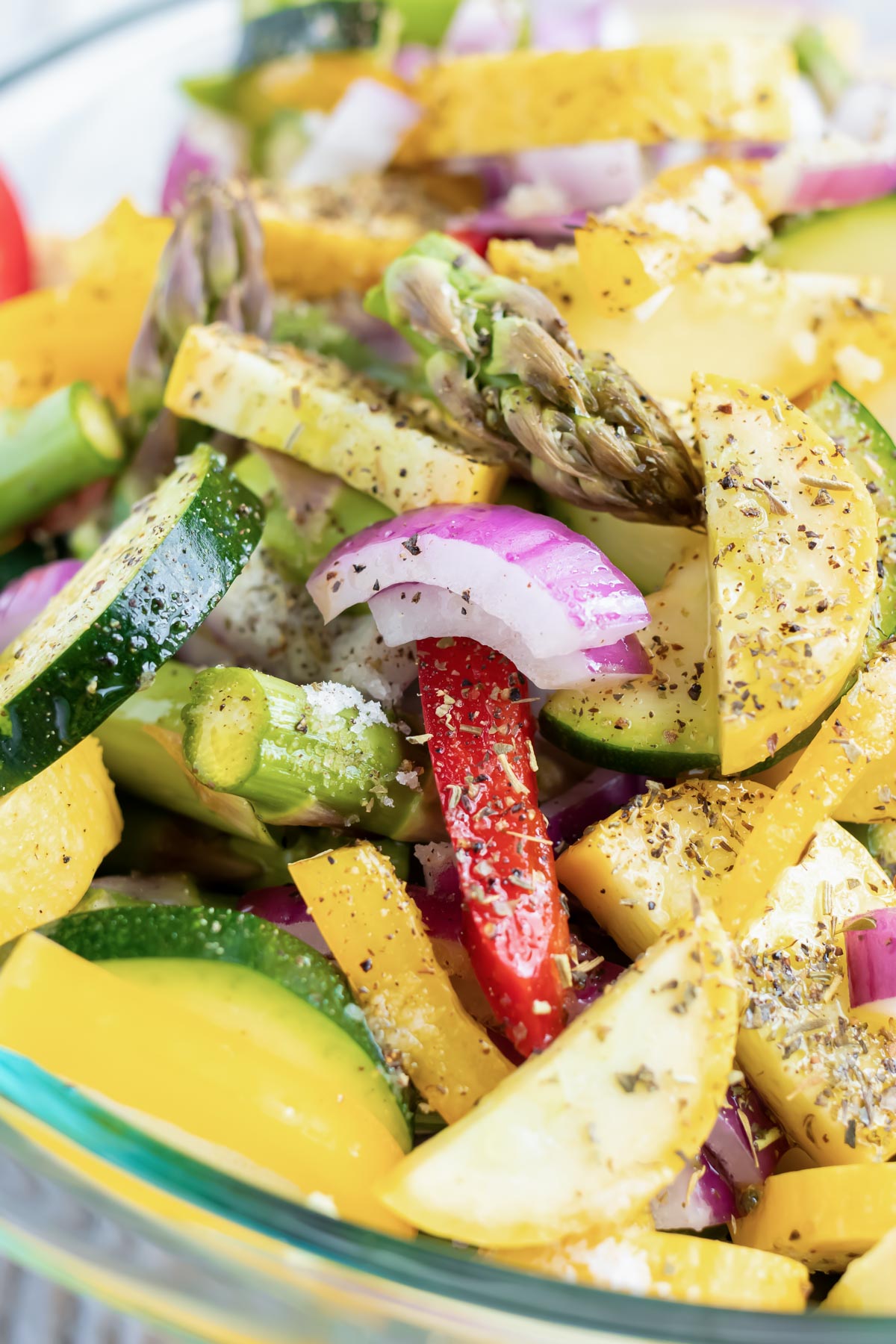

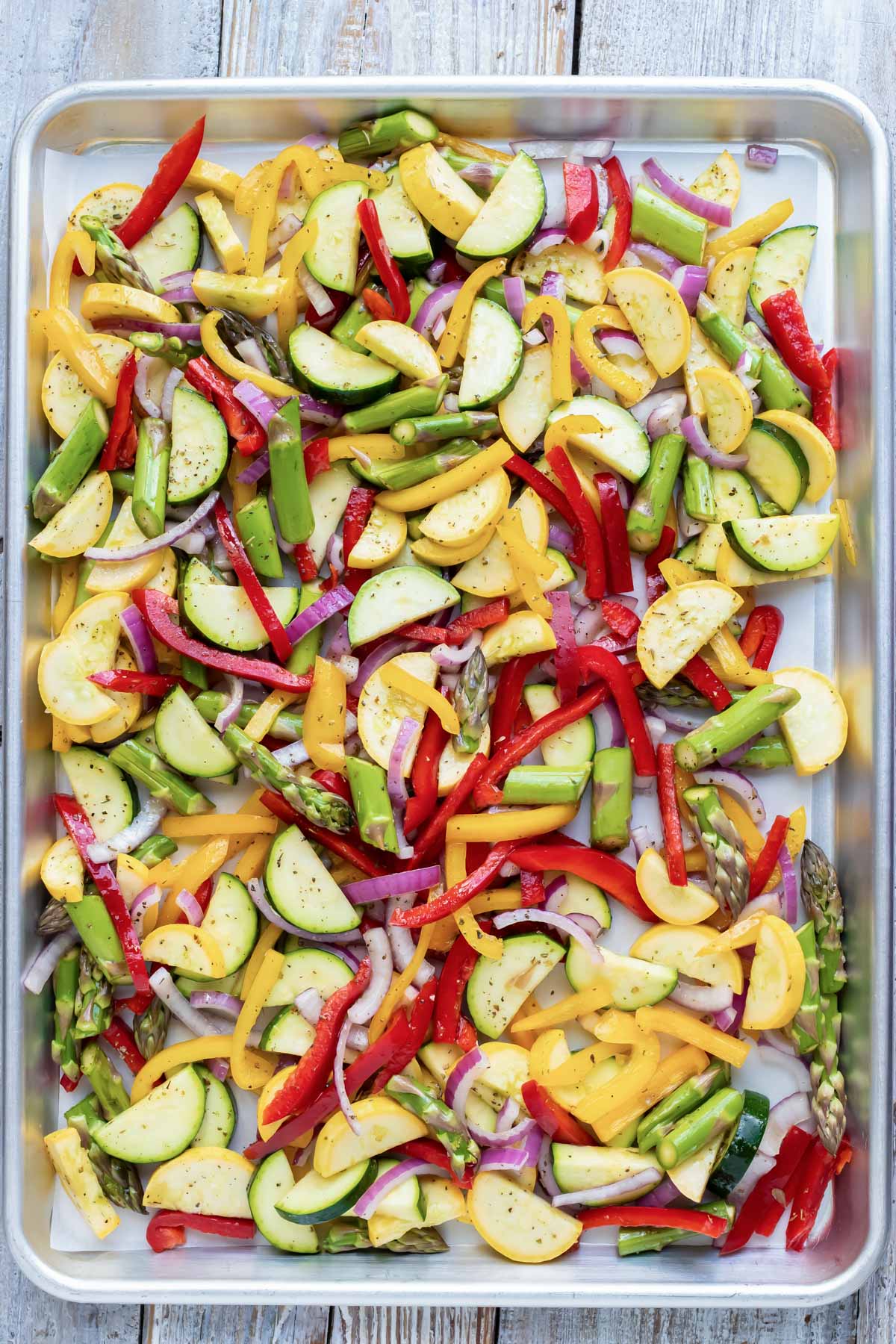

Cook the Pasta and Make the Sauce
Add water to a large pot. Bring it to a boil over medium-high heat. Add pasta to the water and cook until it is al dente. Be sure to follow the package instructions.
Reserve ½-cup of pasta water to add to the sauce.
Lemon, butter, and fresh garlic cloves are the primary ingredients in the sauce. (This is a spin-off of Homemade Garlic Butter.)
It’s amazing what this combination of flavors will do to a pasta dish! And then you add in a bit of fresh basil and voila! You have one of the BEST and EASIEST sauces you’ve ever made.
Add butter, lemon juice and zest, and crushed garlic cloves to a medium-sized pot. (Learn how to zest a lemon 5 different ways if you don’t already know how!)
Whisk ingredients over medium-low heat or until garlic becomes slightly browned.
Mix it Up
Toss sauce with pasta, fresh basil, and Parmesan cheese. Add additional reserved pasta water until desired sauce consistency is reached.
Add salt and black pepper, to taste. Enjoy!
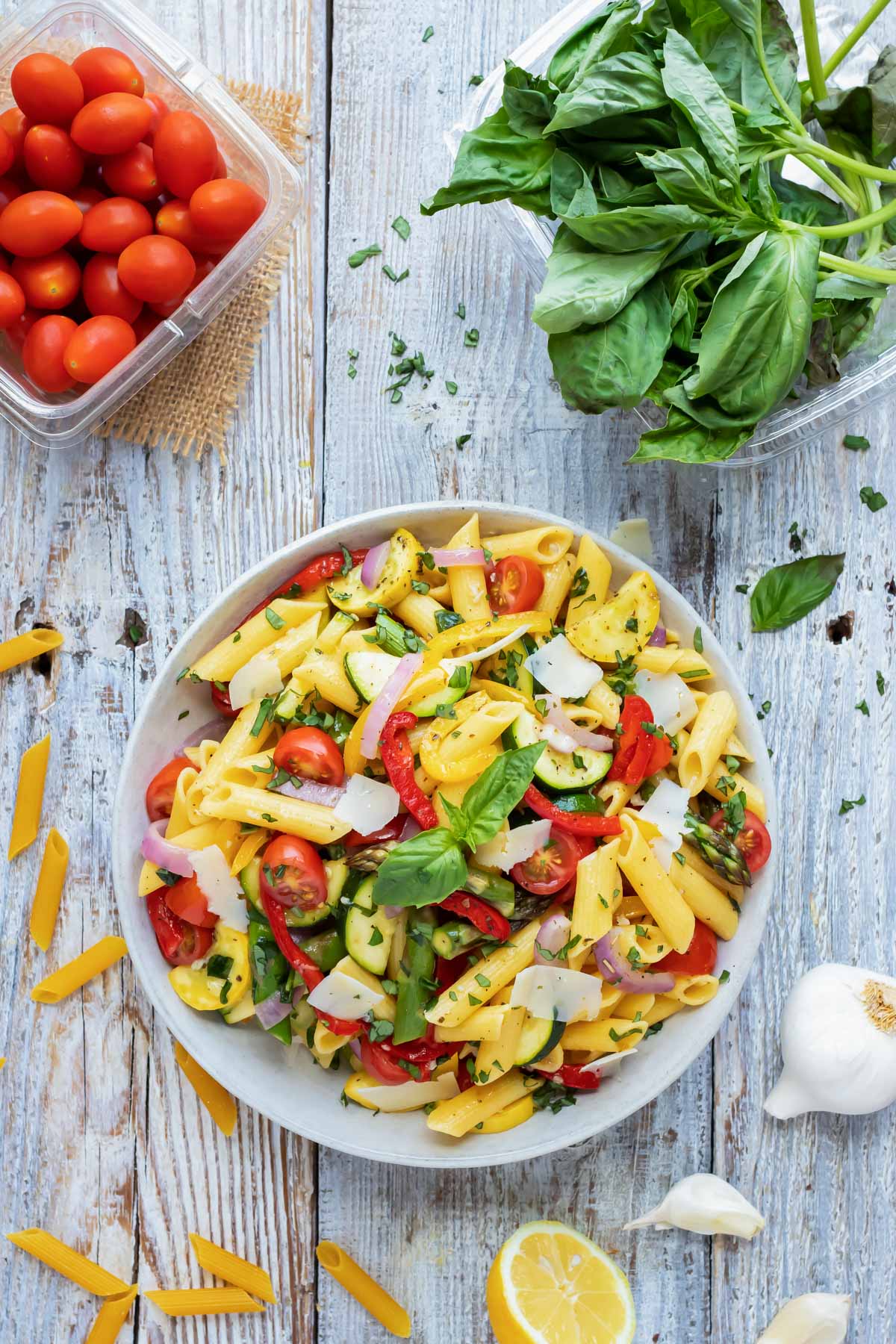

Meal Prep and Storage
- To Prep-Ahead: To be honest, this recipe tastes the absolute best when it is freshly made. You can chop the vegetables and roast them ahead of time, just warm them up before combining with the sauce and pasta.
- To Store: Keep this pasta recipe in an airtight container in the refrigerator for up to 3-4 days.
- To Freeze: Pasta does not freeze well. The texture will be different when thawed.
- To Reheat: Warm it up on the stovetop or in the microwave when ready to enjoy the leftovers. Just make sure you add a touch of water when reheating to give the pasta a softer texture.
Cook’s Tip: Gluten-free pastas do tend to break down more quickly than gluten-filled pastas when reheated. Stay away from the corn-based pastas to avoid this if you know you would like to enjoy some as leftovers.
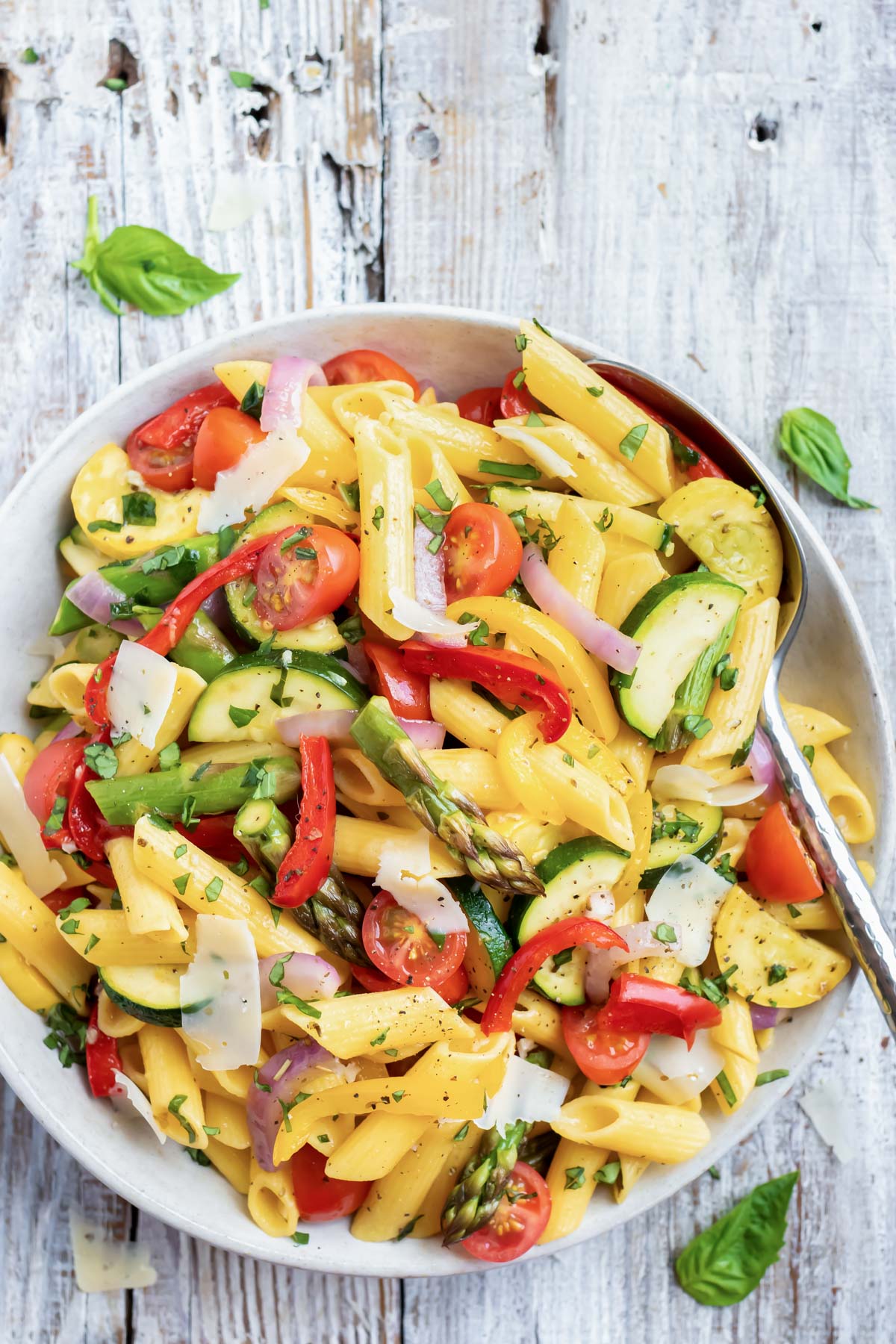

Dietary Modifications
The recipe you’ll find below is already vegetarian as written. Here are some adjustments and substitutions you can make to help it fit your other dietary requirements:
- Gluten-free – Opt for a wheat-free pasta variety.
- Vegan – You will need to use a vegan butter substitute, such as the one by Earth Balance. Choose vegan Parmesan cheese or substitute nutritional yeast flakes, instead.
- Dairy-free – Leave out the cheese and go for a dairy-free butter.
FAQs
This dish is an American invention that contains pasta and vegetables mixed with a creamy lemon garlic sauce.
In Italian, primavera means spring. This dish is called pasta primavera because it consists of fresh, spring vegetables along with noodles and sauce.
Traditionally, primavera sauce is made with broth, spices, cream, and cheese. However, there are many variations. In this recipe, we went with a lighter lemon garlic butter sauce.
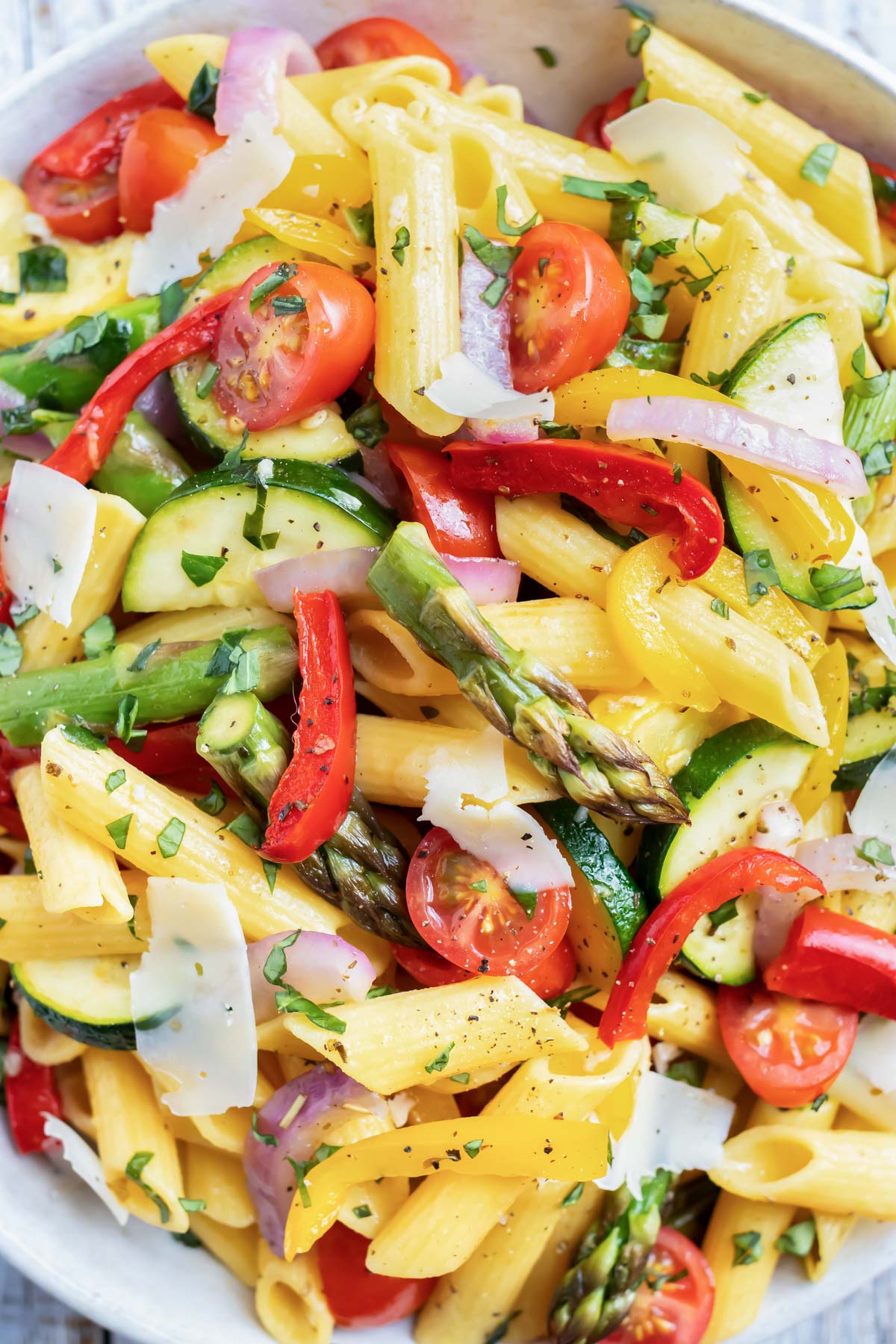

Expert Tips and Tricks
- Go fresh. It is essential to use raw, never frozen veggies in this dish to maintain the best flavor and texture.
- Change it up. You can use any vegetables you have on hand, try broccolini, snap peas, green beans, or sweet peppers.
- Give it a roast. Boiling or sautéing the veggies doesn’t give quite the same subtly sweet flavor they get from the oven.
- Top it off. Do not forget the fresh basil and cherry tomatoes before serving!
- Add some water. When you reheat the pasta, be sure to add a little bit of water to get it soft again.
What to Serve with Pasta Primavera
Any of these recipes pair perfectly with pasta primavera:
Other Pasta Recipes
If this fresh recipe has you craving another pasta dish, try one of these next:
Email this recipe!
Enter your email and we’ll send it directly to you.
Lemon Garlic Butter Sauce
Prevent your screen from going dark
Roasted Vegetables:
Preheat oven to 425℉.
Toss zucchini, squash, peppers, onion, and asparagus in a large bowl with 2 tablespoons olive oil, 1 teaspoon salt, ¼ teaspoon pepper, and 1 teaspoon Italian seasonings.
Place vegetables on a large parchment paper-lined baking sheet. Bake for 15-17 minutes, or until vegetables are tender.
Lemon Garlic Butter Sauce:
In the same pot that the pasta was cooked in add butter, lemon juice and zest, and crushed garlic. Saute over medium-low heat for 1-2 minutes or until garlic is slightly browned.
Add cooked pasta, ¼ cup reserved pasta water, and vegetables. Toss until pasta is well coated in sauce.
Add chopped basil, Parmesan cheese, tomatoes, and 1 teaspoon salt, to taste. Toss until well combined.
Serve pasta primavera with additional Parmesan cheese and basil. Enjoy!
Meal Prep and Storage
- To Prep-Ahead: To be honest, this recipe tastes the absolute best when it is freshly made. You can chop the vegetables and roast them ahead of time, just warm them up before combining them with sauce and pasta.
- To Store: Keep this pasta recipe in an airtight container in the refrigerator for up to 3-4 days.
- To Freeze: Pasta does not freeze the best. The texture will be different when thawed.
- To Reheat: Warm it up on the stovetop or in the microwave when ready to enjoy the leftovers. Just make sure you add a touch of water when reheating to give the pasta a softer texture.
Calories: 488kcal, Carbohydrates: 70g, Protein: 17g, Fat: 17g, Saturated Fat: 7g, Cholesterol: 27mg, Sodium: 856mg, Potassium: 706mg, Fiber: 7g, Sugar: 9g, Vitamin A: 2445IU, Vitamin C: 83.5mg, Calcium: 177mg, Iron: 3.7mg
Nutrition information is automatically calculated, so should only be used as an approximation.

